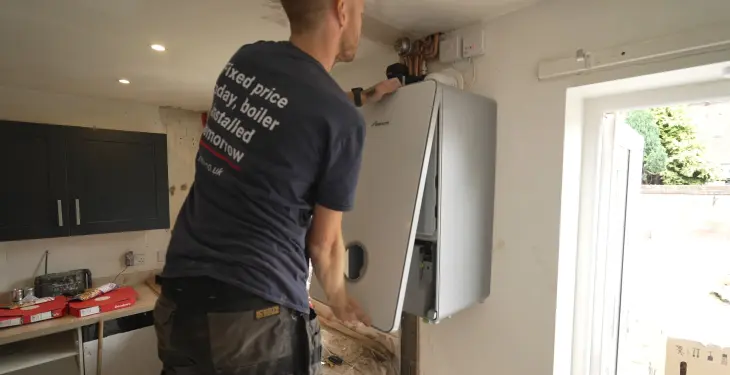

Written by Stephen Day
Gas Safe Engineer
Updated: 30th May, 2025
Taking care of your Glow-worm boiler means not only understanding how to reset it but also knowing when to call in a professional. Having a well-maintained boiler contributes to a cosy and warm home, regardless of the season.
Get a new boiler quote, save up to £550 per year (0% APR available).
Resetting a Glow-worm boiler can seem daunting, especially when you're freezing at home with no heating or hot water. Understanding how to reset your boiler can save you time and the cost of a professional service call. To reset your Glow-worm boiler, locate the red button usually found on the front or side, press and hold it for 10 seconds, and wait for the boiler to restart.
There is more to maintaining your boiler than just a reset. Regular checks and maintenance help ensure your system runs efficiently and lasts longer. Knowing the signs to watch for, such as low water pressure or a faulty thermostat, can often allow you to resolve simple issues without professional help.
Taking care of your Glow-worm boiler means not only understanding how to reset it but also knowing when to call in a professional. Having a well-maintained boiler contributes to a cosy and warm home, regardless of the season.
Get a quote in 60 seconds, fitted as fast as next day!
0% APR finance available.
Glow-worm boilers are central to many UK homes, offering reliable heating and hot water. Knowing the types of boilers available and the importance of regular upkeep can help maintain their performance and efficiency.
Glow-worm offers several types of boilers, each with specific features suited to different needs.
Combi Boilers: These combine water heating and central heating in one unit. They are efficient and ideal for small to medium homes.
System Boilers: System boilers have a separate hot water cylinder. This type is suitable for homes with high hot water demand.
Regular Boilers: Also known as conventional boilers, these require a separate cylinder and water tank. They are compatible with older heating systems and can supply multiple taps simultaneously.
Choosing the right type depends on factors like household size, hot water usage, and existing plumbing.
Regular maintenance of a Glow-worm boiler ensures optimal performance and prevents breakdowns.
Annual Servicing: It’s crucial to have the boiler serviced annually by a certified engineer to maintain safety and efficiency.
Cleaning: Dust and debris can accumulate inside the boiler, affecting its efficiency. Routine cleaning can prevent this.
Checking Pressure: Low water pressure can hinder the boiler’s performance. Regularly check and maintain the correct pressure level.
Inspecting Components: Key parts like the thermostat, heat exchanger, and ignition system should be inspected to ensure they are working properly.
Regular maintenance prolongs the boiler’s lifespan and can save on repair costs in the long run.
Before resetting your Glow-worm boiler, it's essential to perform certain checks and gather the appropriate tools. These steps ensure safety and help identify potential issues that may need a professional's attention.
Safety should be your first priority. Turn off the boiler and disconnect it from the power supply. Let it cool down for at least 15 minutes to avoid burns or other injuries.
Check for gas leaks by smelling around the boiler area. If you detect gas, evacuate immediately and contact an engineer. Wearing protective gloves and following manufacturer guidelines can also prevent accidents.
You'll need a few basic tools and equipment to reset your Glow-worm boiler. A user manual is crucial for locating the reset button and understanding fault codes.
A set of screwdrivers might be required to open boiler panels. A digital pressure gauge can help you check water pressure. Finally, a flashlight is useful for inspecting hard-to-see areas.
Glow-worm boilers come in different models, each with unique user controls and interfaces. Locate the model number, usually found on a sticker or plate on the boiler. This will help you refer to the correct section in the user manual.
The reset button can vary in location and appearance depending on the model. It's generally a small red or black button. Understanding your specific model and its controls can make the resetting process more efficient.
Resetting a Glow-worm boiler involves finding the reset button and understanding common fault codes that the boiler might display. Knowing these can help fix issues like low water pressure or ignition faults.
The reset button on Glow-worm boilers is usually easy to find. Typically, it's a red button located on the front or side panel of the boiler.
First, ensure the boiler is turned on. Then, locate the button. In some models, the reset button is marked with a reset label, making it easier to identify.
To reset the boiler, press and hold the button for 3-10 seconds. The boiler will then go through a restart cycle which may take a few minutes. If the button needs to be held for a different duration, check the boiler's manual.
Glow-worm boilers show fault codes starting with the letter "F" for various issues:
F16: Flame detection fault. Ensure gas supply is on and the flame sensor is clean.
F22: Low water pressure. Check pressure gauge and add water if below 1.0 bar.
F27: Incorrect flame detected. Turn off the boiler and restart. If it persists, call a technician.
F28 and F29: Ignition faults. These codes often appear due to gas supply issues. Make sure the gas valve is open and reset the boiler.
If a fault code persists after resetting, it is advisable to call a heating engineer. They can diagnose and repair complex issues, ensuring the boiler functions properly.
Understanding these common fault codes and how to address them will help in maintaining the boiler's efficiency and avoiding unnecessary disruptions.
After resetting your Glow-worm boiler, certain checks and observations are crucial to ensure it functions correctly. This section outlines what to look for and when it's necessary to seek professional help.
Once you have reset the boiler, pay close attention to its behaviour. Listen for unusual noises like banging or whistling, which may indicate underlying issues.
Check the pilot light. It should be stable and blue. If it flickers or turns yellow, this might signal a problem with gas supply or combustion.
Monitor fault codes on the display. Persistent or new fault codes could suggest that the reset did not resolve the problem, or there are other faults present.
Next, look for leaks around the boiler. Water leaks often indicate high pressure or faulty components. Even a minor drip can be a sign of bigger issues. Additionally, ensure the thermostat and radiators are working correctly, confirming that the boiler is heating efficiently.
Reach out to an engineer if the boiler does not return to normal operation or displays persistent fault codes. Professionals can diagnose complex issues that simple resets cannot fix.
If you detect gas smells or if the pilot light keeps going out, these are serious issues needing urgent attention from a qualified professional.
Leaking water is another red flag. Continuous leaks after a reset might indicate maintenance is necessary or parts need replacement. Always prioritise safety and avoid trying to fix complex issues on your own.
Lastly, if the boiler repeatedly needs resetting, it’s a sign of deeper problems perhaps requiring an expert diagnosis and more extensive repair work.
Proper maintenance of your Glow-worm boiler ensures it runs efficiently and lasts longer. Key aspects include scheduling an annual service, maintaining optimal water pressure levels, and performing seasonal checks.
An annual service is crucial for your boiler's health. A qualified technician examines and cleans components, checks for wear and tear, and ensures optimal performance. Regular servicing helps catch small issues before they become big problems.
An annual service is often required to keep your warranty valid. Service appointments should be scheduled with an approved engineer. Make sure to keep a record of each service, as this can be useful for future reference.
Your Glow-worm boiler functions best at the right water pressure. If the pressure is too low, the boiler won't work properly. Too high pressure can cause damage.
It's a good idea to check your boiler’s pressure gauge often. The ideal range is usually between 1.0 and 2.0 bar. If the pressure drops below this range, you may need to repressurise the system.
To repressurise, locate the filling loop, often found under the boiler. Follow the manufacturer's instructions or consult a professional for guidance.
Seasonal checks help your boiler cope with temperature changes. In autumn, bleed your radiators to remove air pockets that can cause uneven heating. Check for any visible leaks or corrosion.
During winter, it’s wise to keep your boiler running regularly to prevent pipes from freezing. Setting the thermostat to a consistent temperature can also help.
In warmer months, turn on your boiler occasionally to ensure all components are working. Regular adjustments and monitoring help maintain efficiency year-round.
By keeping up with these maintenance tasks, your Glow-worm boiler will run smoothly and efficiently, providing reliable heating and hot water for your home.
When dealing with advanced issues with a Glow-worm boiler, it is important to know how to address persistent fault codes, recognise when replacement parts are necessary, and manage leaks and blockages that may arise.
Persistent fault codes on a Glow-worm boiler can be troubling. Start by referencing the boiler’s manual to understand the specific meaning of each code.
Common fault codes include F1 (low pressure) or F28 (ignition failure). Often, these issues can be resolved by resetting the boiler, but if the fault code reappears, it might indicate a deeper issue that requires professional intervention.
Steps to handle persistent fault codes:
Identify the code: Use the manual or search online.
Reset the boiler: Hold the reset button for the specified time.
Check for simple fixes: Such as topping up water pressure.
If these steps do not solve the issue, it may be time to call a certified engineer.
Knowing when to replace parts is crucial in boiler maintenance. Ignoring worn-out components can lead to bigger problems.
Diverter valves are a common part that may need replacement. If there is a lack of hot water or inconsistent heating, the diverter valve could be the culprit.
Signs that parts may need replacement:
Strange noises: Banging or whistling sounds.
Inadequate heating: Rooms not heating properly.
Visible damage: Any signs of wear or corrosion.
Regular servicing by a professional can help identify these issues early and avoid unexpected breakdowns.
Leaks and blockages in a boiler can cause significant damage. It is important to address these complications promptly.
Identifying and fixing leaks:
Inspect seals: Look for wear and tear around connections.
Check pressure relief valve: Ensuring it is not leaking.
Monitor water pressure: Unusually low pressure might indicate a leak.
Addressing blockages:
Check for buildup: Inspect internal components for lime scale or debris.
Clean filters: Ensure any water filters are clean and unobstructed.
For severe leaks or persistent blockages, contacting a qualified boiler repair technician is advisable to prevent further damage.
To keep your Glow-worm boiler running smoothly for years, it's essential to focus on boosting its efficiency and employing long-term care practices.
Keeping your boiler running efficiently can save energy and lower bills. One method is to insulate exposed pipes. This reduces heat loss and stops the boiler from working harder than needed.
Another tip is setting the thermostat to the right temperature. 20-21°C for living areas and 16-18°C for bedrooms is recommended. Avoiding high settings prevents overheating and saves energy.
Regularly bleeding radiators also prevents trapped air, making your system heat more effectively. Checking and maintaining boiler pressure ensures the system operates smoothly without straining the components.
Proper care can prevent problems and extend the lifespan of your boiler. Annual servicing by a professional is crucial. It helps catch minor issues before they become major problems. Vaillant Group recommends this practice for all their models, including Glow-worm.
Keeping the area around the boiler clear allows proper ventilation and reduces the risk of overheating. Descaling the boiler in hard water areas minimises limescale build-up that can reduce efficiency.
Lastly, consider investing in quality parts for any replacements. High-quality components may be more efficient and last longer, ensuring the boiler remains reliable. Following these steps keeps the system more efficient and durable.
For issues that aren't resolved by a simple reset, professional help may be needed. It's important to know how to find qualified engineers and understand boiler cover and warranty options.
When dealing with boiler issues, always hire a Gas Safe registered engineer. This ensures that they are certified to work safely on gas appliances. To find one:
Visit the Gas Safe Register website.
Use their search tool to locate qualified engineers in your area.
Check credentials by asking for their Gas Safe ID card.
Booking an appointment with a Gas Safe engineer guarantees that your boiler will be handled by a professional. They can diagnose and fix problems that are beyond simple DIY fixes, including complex faults and safety checks.
Understanding your boiler's warranty and available cover options is crucial. Key points:
Warranty: Most Glow-worm boilers come with a warranty ranging from 2 to 7 years. It's vital to register your boiler after installation to activate this protection. Keep a record of the purchase and installation dates.
Boiler Cover: Consider purchasing a boiler cover plan. These plans often include:
Annual servicing
Priority repairs
No added costs for parts and labour during repairs
Review the terms and conditions of any cover plan to ensure it suits your needs. Having this cover can save time and money on unexpected repairs and replacements.
Resetting a Glow-worm boiler is a straightforward process that can often resolve minor issues like low water pressure or a faulty thermostat.
To reset, locate the reset button, which is usually red and found on the front or side of the boiler. Hold the button for 3-10 seconds, depending on the model.
After resetting, the boiler may take a few minutes to restart. If issues persist, professional assistance might be required.
Regular maintenance and annual servicing are essential for preventing faults and ensuring efficient operation.
For more detailed instructions, always refer to your boiler's manual. Staying informed about your specific model is crucial for effective troubleshooting.
Last updated: 30th May, 2025

Written by Stephen Day
Gas Safe Engineer at iHeat
Stephen Day is a Gas Safe registered and FGAS certified engineer with over 20 years of hands-on experience in the heating, cooling, and renewable energy industry, specialising in boiler installations, air conditioning, and heat pump systems.
LinkedInArticles by Stephen Day are reviewed by iHeat’s technical team to ensure accuracy and reliability.

22nd December, 2025
Based on data from over 7000 boiler installations completed by iHeat in the past 12 months...
 Read Article
Read Article

22nd December, 2025
Here’s a quick roundup of the best combi boilers for 2026.
 Read Article
Read Article

22nd December, 2025
When your old boiler breaks down and it comes time to replace it with a new one, it might...
 Read Article
Read Article
No obligation. Takes less than 60 seconds.